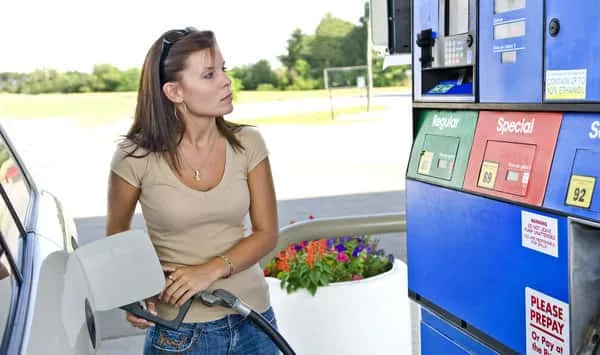If the stars continue to align according to forecast, the highest gasoline prices of 2019 “may now be in your rearview mirror.” That’s the assessment from a new AAA survey report out this week, which also shows that overall we might actually be “numbing to the ‘pain at the pump.'”
The Auto Club has released a summer forecast suggesting that the national gas price average will drop to $2.70 in the weeks ahead.
The interesting part of the equation is that while that forecast might bring smiles to many faces, just last year that amount was considered to be “too expensive.” That leads AAA to suggest that when it comes to filling-up at the pump, Americans are changing their perception of what they consider “too expensive.”
AAA’s 2019 Gas Price survey finds that 50-percent of us think paying $3.00 per gallon is too high – an increase of 30-cents from last year when half of us reported $2.70 was too expensive. 2019’s price point is also 50-cents more than in 2016, when half of us thought $2.50 was too much to pay at the pump. With gas price sensitivity lowering over the past three years, AAA suggests, “Americans are feeling numb to the pain at the pump.”
Jeanette Casselano from AAA says, “For consumers today, paying more to fill-up their gas tank may feel less shocking due to the national average pushing within pennies of $3.00 per gallon the last two spring seasons,” and adds, “However, there is good news this summer – the highest prices of the year could be in the rearview mirror.” Casselano says, “With most refineries operating at normal levels, demand at robust rates, and cheaper crude oil prices, summer gas prices are poised to be a little less than last year –dropping as much as a dime to lower the national average to $2.70.”
The Auto Club says that even with many among us being more tolerant of higher gas prices, you can still expect 74-percent of Americans to make lifestyle changes to offset increased pump prices. Of those, nearly a quarter (24-percent) say $2.75 – a price consumers will see for sure at the pump this summer — as the price that would push them toward changing habits or choices, including:
- Combining errands or trips – 65-percent (down from 79-percent in 2018)
- Driving less – 60-percent (down from 73-percent in 2018)
- Reducing shopping or dining out – 49-percent (down from 61-percent in 2018)
- Delaying major purchases – 43-percent (down from 50-percent in 2018)
- Driving a more fuel efficient vehicle – 35-percent (down from 46-percent in 2018)
This year, the most expensive West Texas Intermediate (WTI) crude oil prices, which AAA tracks to understand impact on pump prices, have ranged between $65 and $66 per barrel. Most recently WTI crude fell as low as $53/bbl. That is cheaper than last summer when prices ranged between $65 and $73 per barrel – with most daily prices hovering just under $70 per barrel. Historically, crude oil prices and domestic gasoline demand have determined the price Americans pay at the pump in the summer months. And, that’s no different this summer.
The International Energy Agency noted in its May 2019 Oil Markets Report that global crude supply decreased as a result of reduced exports from Canada, Iran and other major crude exporters. If the Organization of the Petroleum Exporting Countries (OPEC) and its partners, including Russia, decide to extend their current production reduction agreement of 1.2 million b/d through the end of 2019, that would further tighten the global crude market. OPEC extending its agreement will also likely lead to increased crude prices that would increase the price of gasoline around the world. It could also entice U.S. crude producers to export more crude, which could tighten supplies in the U.S. and raise retail prices at home. OPEC and its partners will meet on June 25th and 26th in Vienna, where they are expected to announce if the agreement will remain in effect.
For domestic gasoline demand, summer 2019 has been forecast to reach some of the highest levels on record in the U.S. Meanwhile, domestic gasoline stocks are at their lowest level going into June since 2016. If demand rises while gasoline stocks remain low, pump prices could see modest increases, especially if supply is tight in local markets. On the other hand, gas demand could fall, as has occurred in recent weeks due to inclement weather from the Rockies to the Midwest and South. Moreover, the added threat of a major hurricane making landfall could also impact demand, which could suppress pump prices.
In its 2019 Atlantic hurricane season outlook, the National Oceanic and Atmospheric Administration’s Climate Prediction Center said that warmer-than-average sea-surface temperatures in the tropical Atlantic Ocean and Caribbean Sea, ongoing El Nino conditions, and an enhanced West African monsoon could produce nine to 15 named storms – including four to eight hurricanes and two to four major hurricanes. An average hurricane season produces 12 named storms, of which six become hurricanes, including three major hurricanes. The mere threat of a hurricane, especially one that threatens the shutdown of Gulf Coast refineries, can dramatically impact the price of crude and gasoline until normal operations resume.
AAA says, “The price of crude is a driving factor when it comes to retail gasoline prices, accounting for nearly 60-percent of the price you see at the pump year-round. While crude prices have been cheaper this year, AAA is monitoring a number of circumstances that could cause crude oil market prices to increase. This includes reductions in global and domestic crude supply, exports, and U.S. gasoline demand.”
The Auto Club adds, “As Americans settle into summer, many outliers could pave the way for unexpected price bumps, so stayed tuned.” You can always find the latest national and state gas price averages and trends at GasPrices.AAA.com.






